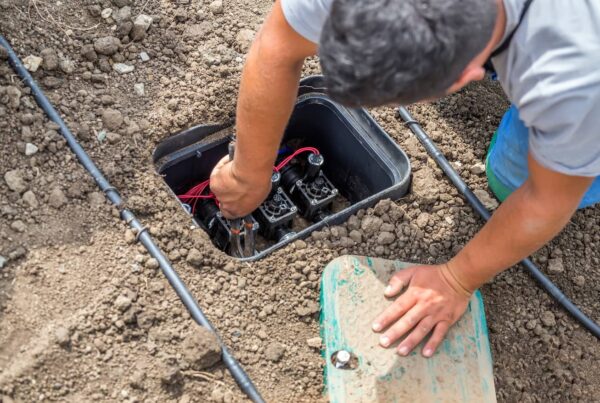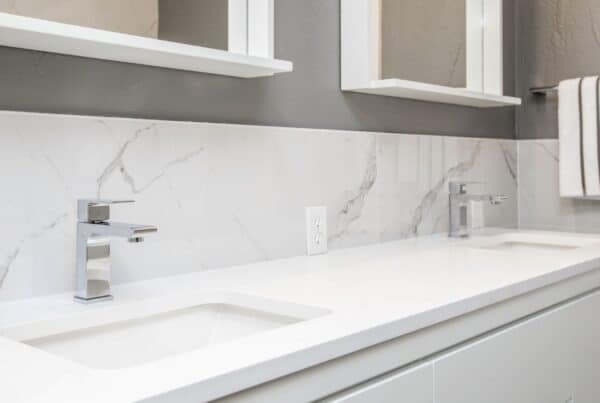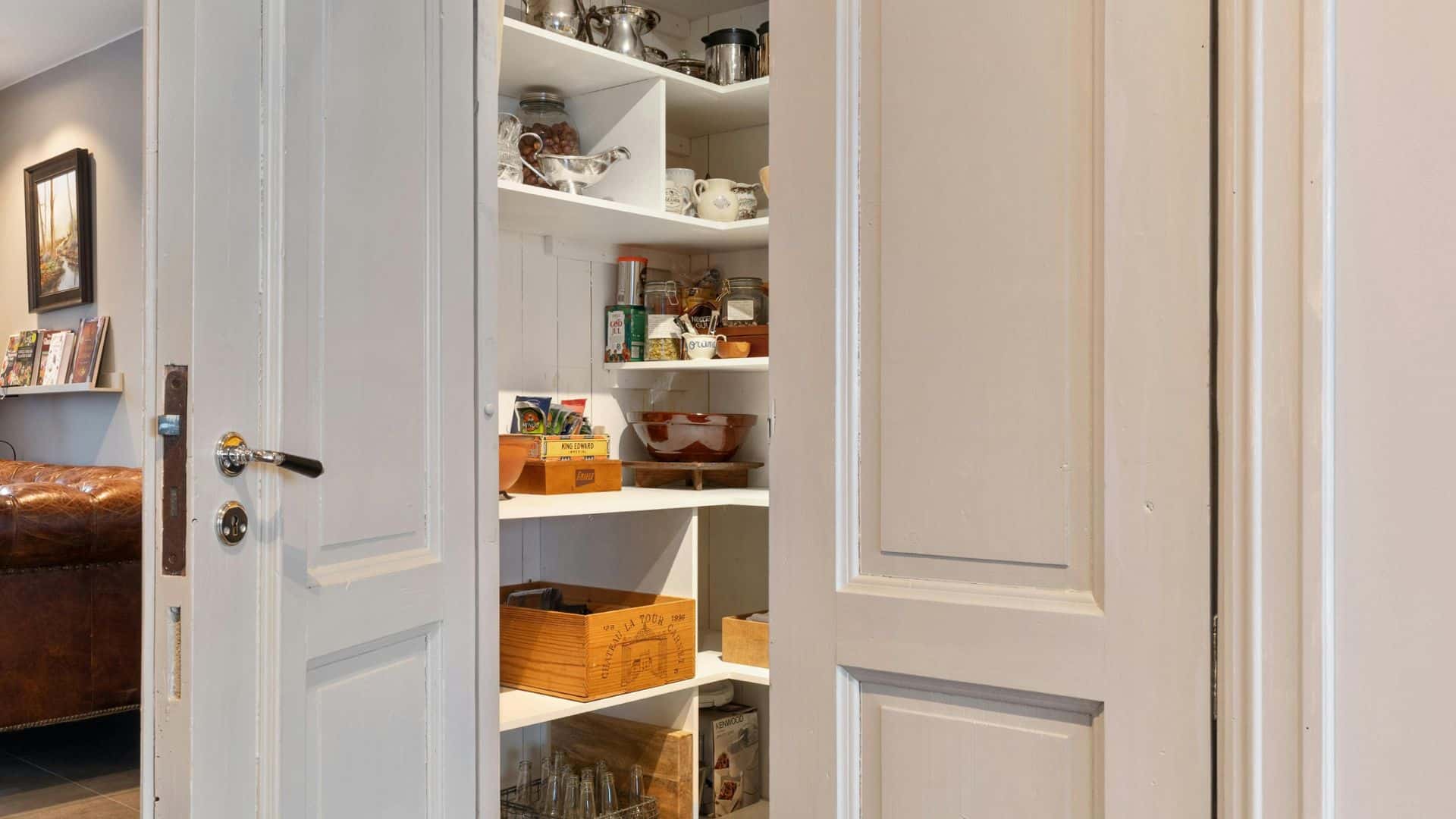
Pantry doors might seem like a small detail in a kitchen, but they play a much larger role than most homeowners realize. Whether you’re building a new home or inspecting an existing one, pantry doors impact functionality, appearance, and even safety.
As home inspectors, we often get questions about what type are best, how to maintain them, and what red flags to look for. In this post, we’ll break it all down so you can make smart decisions.
Why Pantry Doors Matter
Pantry doors help keep your food storage out of sight, protect it from pests and dust, and contribute to the overall look of your kitchen. When they function properly, they are almost invisible in daily life. But when something goes wrong, they quickly become a source of frustration. That’s why understanding your options and how to care for them is important.
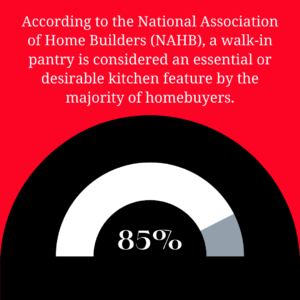
Types of Pantry Doors You Might See
There are several common styles of pantry doors. Each one comes with pros and cons that affect space, design, and usability. Here’s a closer look.
Traditional Swing Doors
-
These are single or double doors that open outward on hinges, just like most interior doors in a home. They’re easy to operate, provide full access to the pantry, and are simple to install. However, they require enough clearance to open, which can be inconvenient in tight or narrow kitchens.
Bi-Fold Doors
-
Bi-fold pantry doors fold in the center and slide along a track, making them ideal for small kitchens or areas with limited floor space. They allow partial access to the pantry with one motion and are often lightweight. However, the folding mechanism can wear out over time, and misalignment can cause the doors to stick or fall off track.
Sliding Barn Doors
-
These trendy doors slide horizontally on an overhead track and add a stylish touch to farmhouse or industrial-style kitchens. They work well in wide, open layouts and are often used as design focal points. But barn-style pantry doors can leave side gaps that allow dust or odors to enter the pantry, and their hardware must be installed properly to prevent warping or uneven sliding.
Pocket Doors
-
Pocket pantry doors slide into the wall, disappearing entirely when open. This is a great space-saving solution for tight kitchens or modern minimalist designs. The challenge is that repairs can be difficult and costly since access to the track is inside the wall. They must also be perfectly installed to avoid jamming over time.
Glass and Frosted Glass Doors
-
These pantry doors add a modern touch and help light travel between rooms. Clear glass is great for open, airy looks, while frosted glass maintains privacy and hides clutter. They work especially well in contemporary kitchens. But keep in mind they show fingerprints easily and may need frequent cleaning to look their best.
Material Choices That Impact Pantry Doors
Pantry doors come in many materials. Each has different benefits depending on your kitchen’s location and style.
Wood
-
Solid wood offers a timeless, warm look and can be customized with paint or stain. It’s strong and durable but sensitive to moisture and temperature swings. Without proper sealing and care, wooden pantry doors can swell, warp, or crack over time.
MDF or Composite
-
Medium-density fiberboard is a budget-friendly material with a smooth finish that mimics solid wood. It’s great for painted pantry doors and resists some warping. However, it’s more susceptible to dents and moisture damage, making it less suitable for humid environments.
Glass
-
Glass adds elegance and light but requires careful cleaning. Pantry doors made from tempered glass are safer, as they’re less likely to shatter into sharp pieces. While visually appealing, they don’t provide as much sound or odor insulation.
Metal
-
Metal pantry doors are rare in residential kitchens but can be found in ultra-modern or industrial-style homes. They’re durable, fire-resistant, and easy to wipe clean. However, they can be noisy to open and close, and the cold feel may not suit every kitchen.
What Home Inspectors Look for in Pantry Doors
When inspecting a home, we always check pantry doors. Problems with pantry doors can point to bigger issues, especially in kitchens. Here’s what we focus on.
-
Proper alignment
We check whether pantry doors open and close smoothly without sticking, dragging, or scraping against the floor. Misaligned doors may indicate foundation settling, door frame shifts, or improper installation. -
Signs of water damage
Pantry doors near plumbing may show swelling, discoloration, or bubbling finishes. These could be signs of leaks from dishwashers, sinks, or pipes behind the wall—issues that require further investigation. -
Hardware condition
Hinges, knobs, latches, and tracks should be secure, rust-free, and fully functional. Loose or corroded hardware can make them difficult to operate and may lead to further damage if ignored. -
Smooth operation
For sliding, barn-style, or bi-fold pantry doors, we make sure they glide smoothly along their tracks without catching, bouncing, or stuttering. Poor operation can signal worn-out rollers or misaligned rails. -
Ventilation
Pantries without airflow can trap humidity, which leads to mold and mildew. We assess whether the pantry space has adequate ventilation, especially if it’s enclosed behind tightly sealed pantry doors. -
Overall condition
We look for cracks, chips, stains, and peeling paint. Damaged doors can mean poor maintenance or suggest environmental issues such as excess moisture or pest activity.
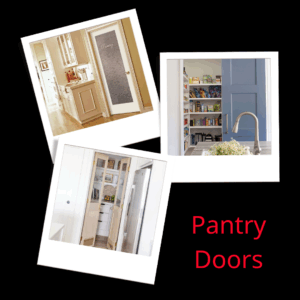
Common Problems Found
We’ve seen a wide range of issues with pantry doors over the years. While some are small and easy to fix, others point to bigger maintenance or design flaws.
-
Doors that scrape the floor or frame
This usually means poor installation or structural shifting. Over time, scraping can wear down flooring and damage the door itself. -
Swollen panels from moisture exposure
Especially common in wood or MDF pantry doors, swelling indicates water damage from nearby sources or poor sealing. -
Bi-fold doors falling off track
If the folding mechanism isn’t properly installed or maintained, bi-fold doors can detach, making the pantry hard to access and creating a safety hazard. -
Sticky sliding doors with poor hardware
Doors that don’t glide properly can wear out tracks and rollers faster. This is common in older homes or DIY installations without proper tools. -
Gaps in barn doors leading to pest entry
Barn-style often don’t seal fully. This can invite bugs and allow kitchen smells to reach your food storage. -
Poorly placed doors too close to counters or walls
If the door can’t swing open completely or blocks access to nearby drawers, it limits the functionality of your kitchen.
These issues don’t just affect looks. They can make your pantry harder to use or lead to pest problems. Catching them early saves time and money later. That’s why pantry doors get close attention during home inspections.
Tips for Choosing and Caring
If you’re replacing them or adding them to a new home, keep a few things in mind.
-
Choose a style that fits your kitchen layout
Avoid doors that block pathways or interfere with appliances. Sliding or pocket doors work better in narrow spaces than swinging doors. -
Make sure they suit your lifestyle
If you open your pantry multiple times a day, a smooth and durable mechanism is essential. Glass or mirrored doors may be less ideal in homes with kids or pets. -
Match materials to your climate
In humid areas, composite or sealed metal doors may last longer than raw wood. Think about how seasonal changes could affect performance. -
Look for easy-clean surfaces
Pantry doors near cooking areas are prone to grease and smudges. Smooth finishes like laminate or glass wipe clean with ease. -
Regular maintenance
Clean tracks and hinges quarterly. Tighten loose screws, touch up paint when needed, and check for warping during seasonal changes.
Pantry doors are part of everyday life. A little attention goes a long way in keeping them functional and attractive.
What to Ask During a Home Inspection
When buying a home, don’t forget to ask your home inspector about pantry doors. Even though they seem minor, they can signal how well the home was maintained. Here are a few questions to ask:
-
Do the pantry doors open and close easily, or are they sticking or dragging?
-
Is there any visible water damage, swelling, or signs of leaks near the door frame?
-
Does the pantry have proper ventilation to prevent mold and stale odors?
-
Is the door style practical for the kitchen’s layout and traffic flow?
-
Will the door material need special upkeep or replacement soon?
These questions help you avoid future repairs and give insight into the overall condition of the home.
Conclusion
Pantry doors matter more than most homeowners think. They affect function, style, and sometimes even your home’s air quality. From traditional swing doors to modern barn styles, the choices are wide. But with the right inspection, you can spot problems early and choose what works best for your space.
If you’re planning to buy a home or update your kitchen, let a professional home inspector help you check the condition of your pantry doors and beyond. Contact our team today to schedule a thorough home inspection and get peace of mind from your pantry to your roof.


